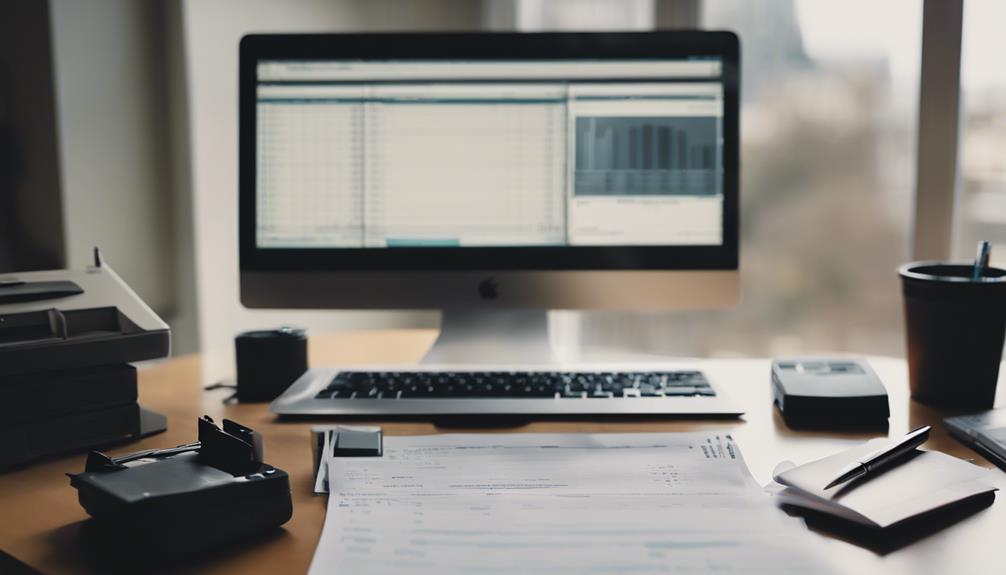You assign custom labels to your bank accounts, known as nicknames, to mentally allocate funds and stay on track with your financial plans by differentiating between various accounts and creating personalized labels for specific purposes. This helps you organize your finances, categorize expenses, and stay focused on your financial goals. By nicknaming your accounts, you can create a mental framework for financial planning, revolutionize your approach to managing money, and improve your saving and budgeting habits. As you learn more about customizing your accounts, you'll discover how nicknaming can transform the way you manage your finances.
Key Takeaways
- A bank account nickname is a custom label assigned to a checking or savings account to categorize funds and track expenses effectively.
- Nicknames help mentally allocate funds, stay on track with financial plans, and differentiate between various accounts.
- Customizing account labels enables effective categorization of funds, aids in budgeting, and improves saving and budgeting habits.
- Nicknames can reflect financial goals or objectives, making it easier to stay organized and motivated to achieve objectives.
- Assigning memorable account aliases enhances financial planning, reflects goals and priorities, and ensures efficient fund allocation.
Understanding Bank Account Nicknames
As you navigate your financial landscape, assigning nicknames to your bank accounts becomes an essential step in taming the complexity of your financial world. By doing so, you can mentally allocate funds for different purposes and stay on track with your financial plans.
A bank account nickname is a customizable label that allows you to designate specific purposes for your accounts. For instance, you can rename your checking account to 'Everyday Expenses' or your savings account to 'Emergency Fund.' This practice helps you differentiate between various accounts, such as your checking account for daily transactions and your savings account for, well, saving money.
Benefits of Customizing Your Accounts

By customizing your bank account nicknames, you can effectively categorize your funds and create a clear mental framework for your financial planning. This simple step can revolutionize your approach to managing your money, whether you're banking with a traditional institution or a credit union.
By assigning meaningful names to your accounts, you'll be looking to make sense of your financial landscape and set yourself up for success over the next two years and beyond. Customizing your account nicknames enables you to mentally allocate funds for specific purposes, such as saving for a down payment on a house or building an emergency fund.
This, in turn, aids in budgeting and setting limits for expenses, helping you stay within your means and avoid financial pitfalls. By dividing your money into different categories through account nicknames, you'll improve your saving and budgeting habits, paving the way for long-term financial stability and security.
Creating Nicknames for Multiple Accounts

You can take your financial organization to the next level by creating distinct nicknames for each of your multiple accounts, making it easier to track and manage your money. This simple step can have a significant impact on your financial management.
By assigning meaningful nicknames to each account, you can mentally categorize your expenses and stay within set limits. For instance, you can rename your savings account to 'Emergency Fund' or your checking account to 'Daily Expenses.' This will help you stay focused on your financial goals and avoid overspending.
Take a few minutes to personalize your accounts by giving them nicknames that reflect their purposes. This will lead to better financial organization and assist you in budgeting and saving.
Nicknaming for Better Organization

As you nickname your bank accounts, you'll find that assigning custom labels brings clarity to your financial landscape, making it easier to categorize transactions and simplify your budgeting system.
By doing so, you'll be able to better organize your finances and make more informed decisions about your money.
With nicknames that reflect the purpose of each account, you'll gain a clearer understanding of your financial priorities and goals.
Custom Labels for Clarity
Assigning custom labels to your bank accounts is a simple yet effective way to bring clarity to your financial landscape. By nicknaming your accounts, you can categorize your finances and allocate funds for specific purposes. This approach helps you track and manage your money more effectively, preventing confusion and simplifying budgeting and financial planning. Custom labels provide a visual representation of where your money is allocated, enhancing your financial awareness and control.
When you nickname your accounts, you can create a system that works for you. For instance, you might label an account 'Emergency Fund' or 'Vacation Savings.' This way, you can quickly identify the purpose of each account and make informed decisions about your finances. With clear labels, you'll be better equipped to manage your money and achieve your financial goals.
Easier Transaction Categorization
By categorizing transactions with custom account nicknames, you can effortlessly track expenses according to their purpose, making it easier to identify areas where you can optimize your spending. With nicknames, you can assign specific labels to different accounts, allowing you to quickly identify where your money is going. This enables you to categorize transactions based on their purpose, such as 'Rent,' 'Groceries,' or 'Entertainment.'
By doing so, you can gain a better understanding of your spending habits and identify areas where you can cut back. With separate account nicknames, you can streamline your budgeting and financial management processes, making it easier to stay within your budget limits. By nicknaming your accounts, you can simplify financial tracking and make it easier to identify areas for improvement.
This, in turn, can help you make more informed financial decisions and achieve your long-term financial goals.
Simplified Budgeting System
You can take your budgeting to the next level by creating a simplified system that relies on nicknames to organize your accounts. This strategy helps you allocate funds more effectively and stay on top of your expenses.
By renaming your accounts with descriptive nicknames, you can mentally divide your money into separate categories. This makes it easier to set spending limits and stay within your budget. This approach, known as mental accounting, is advocated by economist Richard Thaler.
It's similar to labeling envelopes for specific uses, allowing you to allocate funds accordingly. By taking a few minutes to nickname your accounts, you can create a more organized system that enhances your financial management.
This simplified budgeting system enables you to track your expenses more efficiently, ensuring that you're making the most of your money. By implementing this strategy, you'll be better equipped to manage your finances and make more informed decisions about your money.
Bank Account Nickname Ideas

When creating bank account nicknames, you'll want to focus on creating quick identification labels that are easy to remember and understand.
Consider using personalized account names that reflect your financial goals or objectives, such as 'Retirement Savings' or 'Down Payment Fund'.
Quick Identification Labels
With clever bank account nicknames, you can transform confusing account numbers into quick identification labels that speak directly to your financial goals. By assigning specific nicknames, you can easily distinguish between different accounts and track your finances more effectively. This approach helps you stay organized and makes budgeting and managing expenses more intuitive and streamlined.
Here are some examples of how you can use bank account nicknames to create quick identification labels:
- Emergency Fund: a separate account for unexpected expenses or financial emergencies
- Vacation Savings: a dedicated account for saving up for a dream vacation or weekend getaway
- Car Loan Fund: a specific account for saving up for a car loan or other large purchases
Personalized Account Names
By assigning personalized account names, such as 'Dream Wedding Fund' or 'Down Payment Savings,' you can create a customized financial system that mirrors your unique goals and priorities. This helps you categorize and organize your finances for better budgeting. Renaming accounts to reflect their purposes, such as 'Emergency Fund' or 'Vacation Savings,' provides clarity on financial priorities. Using descriptive and personalized nicknames helps you stay motivated to save and stay within set budget limits.
| Account Type | Nickname | Purpose |
|---|---|---|
| Savings | Dream Wedding Fund | Save for wedding expenses |
| Checking | Daily Expenses | Cover daily living costs |
| Investment | Retirement Fund | Build wealth for retirement |
Memorable Account Aliases
You can make your financial planning more engaging and effective by using creative and memorable bank account nickname ideas that reflect your goals and priorities. By assigning personalized titles to your accounts, you can better organize your finances and stay motivated to achieve your objectives.
Here are some memorable account alias ideas to get you started:
- Dream Vacation: A savings account for your next big trip
- Rainy Day Fund: An emergency fund for unexpected expenses
- New Wheels: A savings account for a new car
Using creative nicknames can help you associate specific goals or purposes with each account, making it easier to track your progress and stay focused on your objectives.
Managing Your Nicknamed Accounts

Assigning unique nicknames to your bank accounts is only the first step; now, it's important to manage these nicknamed accounts to maximize their effectiveness. You've taken the initial step by assigning descriptive nicknames that reflect the specific goals or expenses you're saving for in each account.
Now, it's vital to update and modify these nicknames as needed to align with your changing financial objectives.
To keep track of your spending and saving, refer to your account nicknames to stay on budget. This will help you stay organized and focused on your financial goals.
Utilize your bank account nicknames as a tool for effective financial organization and management. By doing so, you'll be able to easily distinguish between your accounts and their purposes, ensuring you're allocating your funds efficiently.
Remember, your account nicknames aren't set in stone – they should evolve as your financial goals and priorities change.
Why Nicknames Improve Banking Experience

Your bank account nicknames play an essential role in streamlining your financial management, making it easier for you to stay on top of your expenses and goals. By assigning meaningful names to your accounts, you can better organize your finances and make informed decisions about your money.
Here are a few ways nicknames can improve your banking experience:
- Clear visual reminders: Nicknames serve as a constant reminder of your financial objectives, helping you stay focused on your goals.
- Easy budgeting: With nicknames, you can quickly identify which account is for savings, expenses, or investments, making budgeting and tracking expenses more manageable.
- Better money management: Personalized account names encourage discipline and responsibility, helping you avoid overspending and make more intentional financial decisions.
Tips for Choosing Unique Nicknames

Five cleverly crafted nicknames can make all the difference in maintaining a stress-free financial life.
When choosing a nickname for your bank account, it's essential to reflect the purpose of the account. For instance, you could name your savings account 'Vacation Fund' or 'Emergency Savings' to remind you of your financial goals.
Avoid generic names like 'Savings Account' and opt for more personalized and motivating names that spark excitement. You can use creativity and humor to make the process of budgeting and saving more engaging.
Consider adding emojis or symbols to make your nicknames visually appealing and easy to identify. Remember to review and update your nicknames regularly to stay motivated and aligned with your financial goals.
Frequently Asked Questions
What Is Your Bank Account Nickname?
Your bank account nickname is a personalized label you've assigned to your account, making it easier to identify and track your finances – it's a name that's meaningful to you, like "Emergency Fund" or "Vacation Savings".
What Do I Put for My Account Nickname?
You can put a descriptive phrase that reflects the account's purpose, like "Summer Vacation" or "Down Payment," as your nickname, making it easy to identify and manage your funds.
Is Account Nickname the Same as Account Name?
Can you think of your account nickname as a mask that reveals its true purpose, while the account name is its official identity? No, they're not the same – your nickname is a personalized label, whereas the account name is provided by the bank.
What Is a Bank Card Nickname?
You're wondering what a bank card nickname is – it's a personalized label for your debit or credit card, helping you identify and organize your cards, making it easier to track spending and manage your finances.
How Can I Set a Nickname for My Bank Account and What Does it Mean?
If you’re wondering about setting a nickname for your bank account, it is important to consider the meaning of “shiesty” slang. A nickname for your account should reflect your personality and values, so choose one that resonates with you. Just be aware of any negative connotations associated with the slang term you choose.
Conclusion
As you've learned, customizing your bank account nicknames is a game-changer for managing your finances. With a few simple clicks, you can transform cryptic account numbers into meaningful labels that make sense to you.
Think of it as having a thousand organized folders in your digital filing cabinet – it's organizational nirvana!
By nicknaming your accounts, you'll save time, reduce frustration, and gain a clearer picture of your financial landscape.










